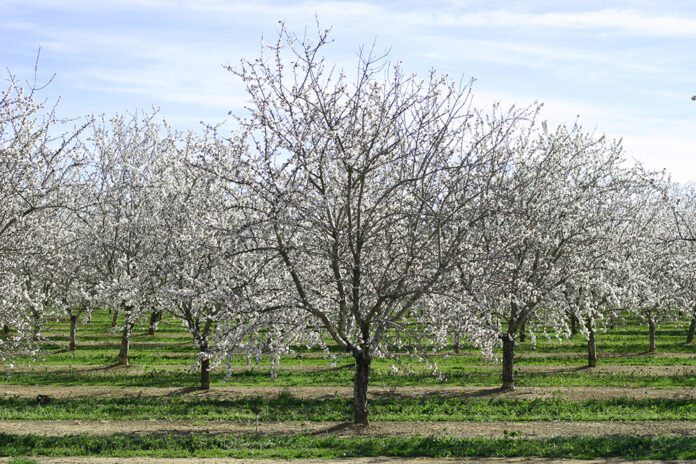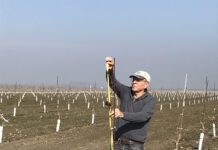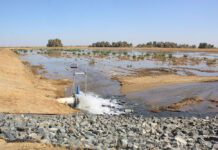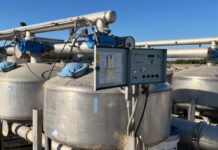
An adage comes to mind this time of year: “No rest for the wicked, and the righteous don’t need it.” It may be a little off base as growers are certainly not wicked, but the work level that happens at this time is far from righteous. It’s intense. Bloom has come and gone for pistachios and almonds, and nutrition is at a pinnacle. The race is on where proper fuel and tire changes are critical to winning it. You must have a good crew and be prepared to feed your trees properly early in the season. Your trees can’t move. They drink their food through the roots and absorb it through the foliage. Feed them the proper diet. Call your CCA and plan if you haven’t already. Here’s a brief list of what that entails:
- Make a list of what nutrients you applied postharvest.
- Look at your tissue results before harvest to see what was lacking.
- Now look at the early tissues to see what is still deficient.
- Plan to address those nutrients first with proper nutrient derivatives. A plant can only drink or absorb certain chemistry. Just applying doesn’t ensure uptake. It’s not what you put on your trees that matters as much as what you get in your trees.
- Schedule the applications to make them efficient. Some can be soil applied while others may need to be in a foliar blend for quicker and more efficient uptake.
- Execute the plan.
So often we get caught up in just doing what we did last year and the year before that. That’s fine if everything is the same and you want the same yields. As we know with farming, everything changes from year to year. Water gets dirtier in drought years. Soils become more leached of soluble nutrients in wet years. Whether it is an element we want to leach like sodium, or one we want to keep like potassium or nitrate, nutrients leach. Plan for that. Iron is darn near impossible to get into a plant in the soil when the pH is above 7. I have growers that tell me they are okay because their soils aren’t that bad at 7.3. 7.3 is not .3 worse; it’s 30 times more basic! The pH number is an inverse log of the H concentration. That’s to the power, not the percentage. You may need to target an acid shot right before an application of nutrients to get better uptake in the soil. There are several acidifying products that can help, and many are easy to handle and apply through your drip or microjets.
Tree nuts start the year high in N and P. If you skimped on a postharvest nitrogen shot, or you are farther south and didn’t get adequate chill, those trees are already at a deficit. If you applied a heavy soil amendment like gypsum that is barely soluble, it’s very hard to get phosphorus into a plant without it tying up in the soil. P is a critical nutrient in creating ATP, or adenosine triphosphate. That’s the energy molecule. It must be higher in the spring when it’s needed most. Blended in the field with a 4- to 5-gallon UAN-32 shot can do wonders early during bloom and while leaves are expanding rapidly. Why just 4 to 5 gallons of N? That’s about 15 units. In early summer, tree nut crops can only take up about 10 units of N per week. Why would we put on a 50-unit slug and think it’ll all be there in the root zone for five weeks while we are irrigating huge slugs of water every week?
The “N” in CAN-17 or UAN-32 is nitrate. It is a negatively charged molecule and will leach. Keeping all those huge slugs of N in the root zone is not possible, especially with long irrigation sets that push water 2 feet or lower. Too much of it leaches and you are wasting money. Just run what is needed every week in shorter sets. We were told for years to put the nutrients in at the end of the irrigation sets to keep more of it higher in the water column. But my argument against that is based on this question: When are your trees most thirsty? I argue it’s right when that water meets the roots. If they have absorbed as much as they can take in a day, how much do we lose because the trees are “full.” Over the next few days, much of our nutrition has flowed below the feeder roots. That is my argument for smaller shots more often in shorter sets, especially when applying nutrition.
At the company I work for, we also add carbon sources and active biology to our NPK blends plus minors to make sure more sticks in the root zone. All the nutrients that carry out intensive and critical enzymatic reactions are present and available with more feedings. C will help hold them there as well as add a key nutrient we don’t usually associate with nutrition. Our trees are mostly C, H and water. They’ll use it and it will hold nutrients in the root zone longer.
You can have the best engine in the world, but without the right fuel, it won’t run properly. Make sure have the octane boost and a solid pit crew addressing those issues efficiently. It takes peak performance to win the race. The team you put in place should include your CCA and your irrigation crew. If that finish line has a bigger paycheck and your engine is still running at peak performance, you’ll make the next race with ease and start on the pole.















